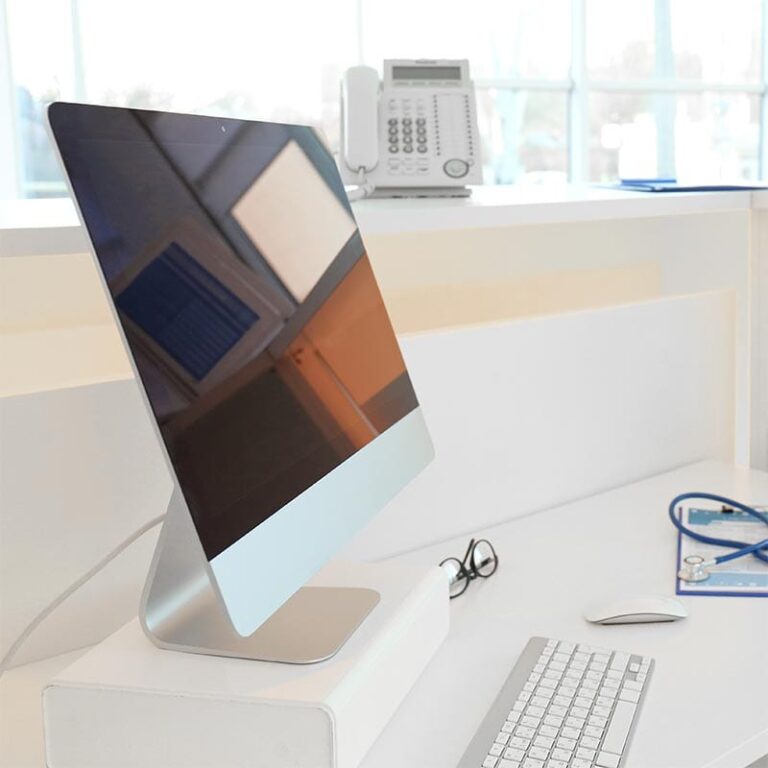A virtual terminal is a web-based interface that allows merchants to process credit card payments.
It’s a way for businesses to accept credit cards without a physical credit card processor, hence the name “virtual.” Virtual terminals make it possible to process payments by phone, mail, fax, and even in person. A virtual terminal is a non-physical software that can turn any desktop computer, laptop, or tablet into a POS system.
How Does a Virtual Terminal Work?
Virtual terminal transactions are processed as “card not present.” It wouldn’t make sense to use a virtual terminal for customers who are physically present at your brick-and-mortar location.
By manually entering credit card information into a web-based application, you can take payments from customers without a card reader.
Think about the form fields on any eCommerce website that need to be filled out to buy something online. A virtual terminal is essentially identical, except it’s used by the business as opposed to the customer.
Here’s a quick overview of how to use a virtual terminal:
- Set up an online account with your payment processor (verify that they offer a virtual terminal).
- Log in to your virtual terminal account.
- Enter the customer details and credit card information as prompted on the screen.
- Submit the payment for processing.
Using a virtual terminal is easy. The interface will vary slightly depending on your payment processor, but the steps will be nearly identical for everyone.

Is a Virtual Terminal Right For Your Business?
Businesses that process transactions over the phone are perfect candidates for a virtual terminal. If you have a physical retail store and only take payments in-person, you probably won’t need a virtual terminal. Learn how to find the best POS system for your business if you fall into that category.
Here are some examples of business types that use virtual terminals on a regular basis:
- Delivery services — Restaurants or other food delivery businesses that take phone orders.
- Local professionals — Doctors, lawyers, or mechanics that allow customers to call and pay over the phone.
- Subscription services — Merchants that automatically charge customers on a recurring basis for software or services.
- Freelancers — Artists or web designers that want to settle client invoices by phone.
Recently, I had to call Sirius XM to renew the satellite radio subscription in my car. They processed my credit card information using a virtual terminal at their call center.
Even if none of these situations apply to your business, there are still circumstances when a virtual terminal will be beneficial and come in handy. If the majority of your sales are processed in-store or online, you should still be prepared to take the occasional phone order.
Some POS software and processors, like Square, offer a free virtual terminal when you sign up for their software.
Benefits of a Virtual Terminal For Credit Card Payment Processing
Virtual terminals have plenty of advantages. I’ve identified the top benefits of using a virtual terminal below.
Process Payments From Anywhere
As long as you have access to a device that connects to the Internet (computer, tablet, or smartphone in some cases), you can log into your virtual terminal from anywhere.
You’ll be able to authorize credit card transactions, send an emailed receipt to your customers, and access your transaction history. This is ideal for business owners who are constantly on the go. You don’t have to be tied to a desk or even be in your office to use a virtual terminal.
Recurring Payments
The best virtual terminals on the market today have settings to enable recurring payments. So if you have a subscription-based business (such as XM radio, as I mentioned earlier), this feature will be perfect for you.
Automated payment processing allows you to collect payments faster without having to contact your customers on a monthly, quarterly, or annual basis. The virtual terminal will keep the customer information on file and charge them automatically upon renewal.
Quick Access to Funds
The amount of time it takes to transfer funds into your account from a virtual terminal will vary based on the processor that you’re using. But in our experience, there shouldn’t be much delay for these web-based transactions.
You will likely have access to funds as quickly as you would from an in-person transaction. Some processors will even offer an instant transfer for an additional fee for virtual terminal processing.
No Hardware Required
You won’t need to buy expensive hardware to use a virtual terminal.
Virtual terminals can be used without a card reader or POS equipment. In most cases, you can use the tablets or computers that you already own to process payments with a virtual terminal.
However, I would not recommend using your personal devices for payment processing. Unless you’re a freelancer or just processing a handful of payments per year, you should still have dedicated devices for business purposes.
Drawbacks of Virtual Terminals
Virtual terminals aren’t perfect. While the advantages are definitely appealing, there are a few pitfalls and cons that you should be aware of.
High Processing Fees
As I said before, virtual terminal transactions are processed as “card not present” purchases. Most credit card processing companies charge a higher rate for these transactions.
For example, Square charges 2.6% + $0.10 to process in-person payments. But merchants are charged 3.5% + $0.15 per transaction for Square Virtual Terminal.
Note: You can always hire a professional merchant consulting firm to negotiate your processing fees.
Extra Security Precautions
Your business needs to have extra security measures in place to process transactions on a virtual terminal. Since the majority of your virtual terminal transactions will be processed over the phone and entered manually, your staff will have access to sensitive customer information.
In addition to training your staff and properly securing your network, you can review our guide on fraud prevention tactics for merchants.
Higher Risk of Chargebacks
Card not present transactions are more susceptible to chargebacks. That’s just a reality that you need to understand.
Chargebacks should not be taken lightly. If you’re using a virtual terminal to process credit cards for your business, check our guide on how to prevent chargebacks for additional information on the subject. This will save you lots of headaches and money down the road.
Final Thoughts on Virtual Terminals
Virtual terminal is necessary for some merchants to process credit card transactions. If your business takes payments over the phone, you need to set up a virtual terminal with your payment processor.
There are pros and cons to using a virtual terminal. Unfortunately, it’s common practice for processors to charge higher rates for using a virtual terminal.
If you want to lower your credit card processing fees, contact us here at Merchant Cost Consulting. We’ll give you a free audit and analysis to find out how much money you can save on credit card processing.

